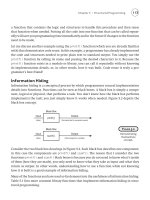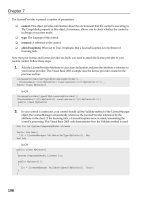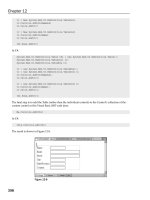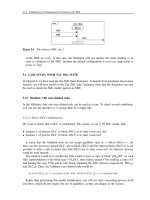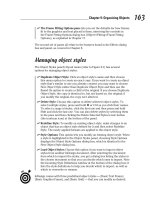Financial Toolbox For Use with MATLAB Computation Visualization Programming phần 5 potx
Bạn đang xem bản rút gọn của tài liệu. Xem và tải ngay bản đầy đủ của tài liệu tại đây (173.8 KB, 40 trang )
cfdates
2-62
2cfdates
Purpose Cash flow dates for a fixed-income security.
Syntax [CFlowDates, CFlowFlags] = cfdates(Settle, Maturity, Period, Basis,
EndMonthRule, IssueDate, FirstCouponDate, LastCouponDate,
StartDate)
Arguments
Settle
Settlement date. A vector of serial date numbers or
date strings.
Settle must be earlier than or equal to
Maturity.
Maturity
Maturity date. A vector of serial date numbers or date
strings.
Period
Coupons per year of the bond. A vector of integers.
Allowed values are
1, 2, 3, 4, 6,and12. Default = 2.
Basis
Day-count basis of the bond. A vector of integers.
0 = actual/actual (default), 1 = 30/360, 2 = actual/360,
3 = actual/365.
EndMonthRule
End-of-month rule. A vector. This rule applies only
when
Maturity is an end-of-month date for a month
having 30 or fewer days.
0 = ignore rule, meaning that
a bond’s coupon payment date is always the same
numerical day of the month.
1 = set rule on (default),
meaning that a bond’s coupon payment date is always
thelastactualdayofthemonth.
IssueDate
Date when a bond was issued.
FirstCouponDate
Date when a bond makes its first coupon payment.
When
FirstCouponDate and LastCouponDate are both
specified,
FirstCouponDate takes precedence in
determining the coupon payment structure.
cfdates
2-63
Settle and Maturity are required arguments. All others are optional.
Required arguments must be N-by-1 or 1-by-N conforming vectors or sca lars.
Optional arguments must be either N-by-1 or 1-by-N conforming vectors,
scalars, or empty matrices.
Any input can contain multiple values, but if so, all other inputs must contain
the s ame number of val u es or a single value that applies to all. For example, if
Maturity contains N dates, then Settle must contain N dates or a single date.
Description [CFlowDates, CFlowFlags] = cfdates(Settle, Maturity, Period, Basis,
EndMonthRule, IssueDate, FirstCouponDate, LastCouponDate,
StartDate) returns a matrix of cash flow dates for a bond or set of bonds.
cfdates determines all cash flow dates for a bond whether or not the coupon
payment structure is normal or the first and/or last coupon period is long or
short.
CFlowDates is an N-row matrix of serial date numbers, padded with NaNsas
necessary to ensure that all rows have the same number of elements. Use the
function
datestr to convert serial date numbers to formatted date strings.
CFlowFlags is the matrix of cash flow flags for a portfolio of bonds. Each row
correspondstothevectorofcashflowflagsforeachbond.Eachelementina
column corresponds to the specific flag associated with each cash flow of a bond.
Flags identify the type of each cash flow (e.g., nominal coupon cash flow, front
LastCouponDate
Last coupon date of a bond prior to the maturity date.
In the absence of a specified
FirstCouponDate,a
specified
LastCouponDate determines the coupon
structure of the bond. The coupon structure of a bond
is truncated at the
LastCouponDate regardless of
where it falls and will be followed only by the bond’s
maturity cash flow date.
StartDate
Date when a bond actually starts (the date from which
abond’scashflowscanbeconsidered).Tomakean
instrument forward-starting, specify this date as a
future date. If
StartDate is not explicitly specified, the
effective start date is the settlement date.
cfdates
2-64
or end partial or “stub” coupon, maturity cash flow). Possible values are shown
in the table.
Flag Cash Flow Type
0
Accrued interest due on a bond at settlement.
1
Initial cash flow amount small er than normal due t o “stub ” coupo n
period. A stub period is created when the time from issue date to
first coupon is shorter than normal.
2
Larger than normal init ial cash flow amo unt beca use first coupon
period is longer tha n norma l.
3
Nominal coupon cash flow amount.
4
Normal maturity cash flow amount (fa ce val ue plus the nominal
coupon amount).
5
End “stub” c oupon amount (last co upon p erio d abno rmally short
and actual mat urity cas h f low is smaller than normal).
6
Larger than normal maturity cash flow because last coupon period
longer than no rmal.
7
Maturity cash flow on a coupon bond when the bond has less than
one c ou p o n period t o m a t u rity.
8
Smaller than normal maturity cash fl ow when bond h a s les s th an
one c ou p o n period t o m a t u rity.
9
Larger than normal maturity cash flow when bond has less than
one c ou p o n period t o m a t u rity.
10
Maturity cash flow on a zero coupon bond.
cfdates
2-65
Examples CFlowDates = cfdates('14 Mar 1997', '30 Nov 1998', 2, 0, 1)
CFlowDates =
729541 729724 729906 730089
datestr(CFlowDates)
ans =
31-May-1997
30-Nov-1997
31-May-1998
30-Nov-1998
Given three securities with different maturity dates and the same default
arguments:
Maturity = ['30-Sep-1997'; '31-Oct-1998'; '30-Nov-1998'];
CFlowDates = cfdates('14-Mar-1997', Maturity)
CFlowDates =
729480 729663 NaN NaN
729510 729694 729875 730059
729541 729724 729906 730089
Look at the cash-flow dates for the last security:
datestr(CFlowDates(3,:))
ans =
31-May-1997
30-Nov-1997
31-May-1998
30-Nov-1998
See Also accrfrac,cpncount,cpndaten,cpndatep,cpndaysn,cpndaysp,cpnpersz
cfdur
2-66
2cfdur
Purpose Cash-flow duration and modified duration.
Syntax [d, md] = cfdur(cf, yld)
Arguments cf Cash flow. A vector of real numbers.
yld Periodic yield. A scalar. E nter as a decimal fraction.
Description [d, md] = cfdur(cf, yld) calculates the duration d and modified duration
(volatility)
md ofacashflowinperiods.
Example Given a cash flow of nine payments of $2.50 and a final payment $102.50, with
a periodic yield of 2.5%:
cf=[2.5 2.5 2.5 2.5 2.5 2.5 2.5 2.5 2.5 102.5];
[d, md]=cfdur(cf, 0.025)
d =
8.9709
(periods)
md =
8.7521
(periods)
See Also bondconv, bonddur, cfconv
cftimes
2-67
2cftimes
Purpose Time factors corresponding to bond cash flow dates.
Syntax TFactors = cftimes(Settle, Maturity, Period, Basis,
EndMonthRule, IssueDate, FirstCouponDate, LastCouponDate,
StartDate)
Arguments
Settle
Settlement date. A vector of serial date numbers or
date strings.
Settle must be earlier than or equal to
Maturity.
Maturity
Maturity date. A vector of serial date numbers or date
strings.
Period
Coupons per year of the bond. A vector of integers.
Allowed values are
1, 2, 3, 4, 6,and12.Default=2.
Basis
Day-count basis of the bond. (Time factors are
computed on an actual/actual basis.
Basis is included
here as an input argument to maintain interface
consistency with other coupon functions.)
EndMonthRule
End-of-month rule. A vector. This rule applies only
when
Maturity is an end-of-month date for a month
having 30 or fewer days.
0 = ignore rule, meaning that
a bond’s coupon payment date is always the same
numerical day of the month.
1 = set rule on (default),
meaning that a bond’s coupon payment date is always
the last actual day of the month.
IssueDate
Date when a bond was issued.
FirstCouponDate
Date when a bond makes its first coupon payment.
When
FirstCouponDate and LastCouponDate are both
specified,
FirstCouponDate takes precedence in
determining the coupon payment structure.
cftimes
2-68
Settle and Maturity are required arguments. All others are optional.
Vector arguments must have consistent dimensions, or they must be scalars.
Description TFactors = cftimes(Settle, Maturity, Period, Basis, EndMonthRule,
IssueDate, FirstCouponDate, LastCouponDate, StartDate)
determines
the time factors corresponding to the cash flows of a bond or set of bonds. The
time factor of a cash flow is the difference between the settlement date and the
cash flow date in units of semi-annual coupon periods.
Example Settle = '15-Mar-1997'
Maturity = '01-Sep-1999'
Period = 2
TFactors = cftimes(Settle, Maturity, Period)
TFactors =
0.9239 1.9239 2.9239 3.9239 4.9239
See Also accrfrac, cfdates, cfamounts, cpncount, cpndaten, cpndatenq, cpndatep,
cpndatepq cpndaysn, cpndaysp, cpnpersz
LastCouponDate
Last coupon date of a bond prior to the maturity date.
In the absence of a specified
FirstCouponDate,a
specified
LastCouponDate determines the coupon
structure of the bond. The coupon structure of a bond
is truncated at the
LastCouponDate regardless of
where it falls and will be followed only by the bond’s
maturity ca sh flow date.
StartDate
Date when a bond actually starts (the date from which
abond’scashflowscanbeconsidered).Tomakean
instrument forward-starting, specify this date as a
future date. If
StartDate is not explicitly specified, the
effective start date is the settlement date.
corr2cov
2-69
2corr2cov
Purpose Convert standard deviation and correlation to covaria nce.
Syntax ExpCovariance = corr2cov(ExpSigma, ExpCorrC)
Arguments
Description
corr2cov converts standard deviation and correlation t o covariance.
ExpCovariance is an N-by-N covariance ma trix, w here N is the number of
processes.
ExpCov(i,j) = ExpCorrC(i,j)*(ExpSigma(i)*ExpSigma(j)
Example ExpSigma = [0.5 2.0];
ExpCorrC = [1.0 –0.5
–0.5 1.0];
[ExpCovariance] = corr2cov(ExpSigma, ExpCorrC)
Expected results:
ExpCovariance =
0.25 –0.5
–0.5 4.0
See Also corrcoef, cov, cov2corr, ewstats, std
ExpSigma
Vector of length N with the s tandard deviations of each
process.
ExpCorrC
N-by-N correlation coefficient matrix. If ExpCorrC is not
specified, the processes are assumed to be
uncorrelated, and the identity m atrix is used.
cov2corr
2-70
2cov2corr
Purpose Convert covariance to standard deviation and correlation coefficient.
Syntax [ExpSigma, ExpCorrC] = cov2corr(ExpCovariance)
Arguments
Description
cov2corr converts covariance to standard deviations and correlation
coefficients.
ExpSigma is a 1-by-N vectorwiththestandarddeviationofeachprocess.
ExpCorrC is an N-by-N matrix of correlation coefficients.
ExpSigma(i) = sqrt(ExpCovariance(i,i))
ExpCorrC(i,j) = ExpCovariance(i,j)/(ExpSigma(i)*ExpSigma(j))
Example ExpCovariance = [0.25 –0.5
–0.5 4.0];
[ExpSigma, ExpCorrC] = cov2corr(ExpCovariance)
Expected results:
ExpSigma =
0.5 2.0
ExpCorrC =
1.0 –0.5
–0.5 1.0
See Also corr2cov, corrcoef, cov, ewstats, std
ExpCovariance
N
-by-Ncovariance matrix, e.g., from cov or ewstats. N
is the number of random processes.
cpncount
2-71
2cpncount
Purpose Coupon payments remaining until maturity.
Syntax NumCouponsRemaining = cpncount(Settle, Maturity, Period, Basis,
EndMonthRule, IssueDate, FirstCouponDate, LastCouponDate,
StartDate)
Arguments
Settle
Settlement date. A vector of serial date numbers or
date strings.
Settle must be earlier tha n or equal to
Maturity.
Maturity
Maturity date. A vector of serial date numbers or date
strings.
Period
Coupons per year of the bond. A vector of integers.
Allowed values are
1, 2, 3, 4, 6,and12.Default=2.
Basis
Day-count basis of the bond. A vector of integers.
0 = actual/actual (default), 1 = 30/360, 2 = actual/360,
3 = actual/365.
EndMonthRule
End-of-month rule. A vector. This rule applies only
when
Maturity is an end-of-month date for a month
having 30 or fewer d ays.
0 = ignore rule, me aning that
a bond’s coupon payment date is always the same
numerical day of the month.
1 = set rule on (default),
meaning that a bond’s coupon payment date is always
the last actual day of the month.
IssueDate
Date when a bond was issued.
FirstCouponDate
Date when a bond makes its first coupon payment.
When
FirstCouponDate and LastCouponDate are both
specified,
FirstCouponDate takes precedence in
determining the coupon payment structure.
cpncount
2-72
Settle and Maturity are required arguments. All others are optional.
Required arguments must be N-by-1 or 1-by-N conforming vectors or scalars.
Optional arguments must be either N-by-1 or 1-by-N conforming vectors,
scalars, or empty matrices.
Description NumCouponsRemaining = cpncount(Settle, Maturity, Period, Basis,
EndMonthRule)
returns the whole number of coupon payments between the
settlement and maturity dates for a coupon bond or set of bonds.
Examples NumCouponsRemaining = cpncount('14 Mar 1997', '30 Nov 2000',
2, 0, 0)
n =
8
Given three coupon bonds with different maturity dates and the s ame default
arguments:
Maturity = ['30 Sep 2000'; '31 Oct 2001'; '30 Nov 2002'];
NumCouponsRemaining = cpncount('14 Sep 1997', Maturity)
NumCouponsRemaining =
7
9
11
LastCouponDate
Last coupon date of a bond prior to the maturity date.
In the absence of a specified
FirstCouponDate,a
specified
LastCouponDate determines the coupon
structure of the bond. The coupon structure of a bond
is truncated at the
LastCouponDate regardless of
where it falls and will be followed only by the bond’s
maturity ca sh flow date.
StartDate
Date when a bond actually starts (the date from which
abond’scashflowscanbeconsidered).Tomakean
instrument forward-starting, specify this date as a
future date. If
StartDate is not explicitly specified, the
effective start date is the settlement date.
cpncount
2-73
See Also accrfrac, cfamounts, cfdates, cftimes, cpndaten, cpndatenq, cpndatep,
cpndatepq, cpndaysn, cpndaysp, cpnpersz
cpndaten
2-74
2cpndaten
Purpose Next coupon date for fixed-income security.
Syntax NextCouponDate = cpndaten(Settle, Maturity, Period, Basis,
EndMonthRule, IssueDate, FirstCouponDate, LastCouponDate,
StartDate)
Arguments
Settle
Settlement date. A vector of serial date numbers or
date strings.
Settle must be earlier than or equal to
Maturity.
Maturity
Maturity date. A vector of serial date numbers or date
strings.
Period
Coupons per year of the bond. A vector of integers.
Allowed values are
1, 2, 3, 4, 6,and12. Default = 2.
Basis
Day-count basis of the bond. A vector of integers.
0 = actual/actual (default), 1 = 30/360, 2 = actual/360,
3 = actual/365.
EndMonthRule
End-of-month rule. A vector. This rule applies only
when
Maturity is an end-of-month date for a month
having 30 or fewer days.
0 = ignore rule, meaning tha t
a bond’s coupon payment date is always the same
numerical day of the month.
1 = set rule on (default),
meaning that a bond’s coupon payment date is always
thelastactualdayofthemonth.
IssueDate
Date when a bond was issued.
FirstCouponDate
Date when a bond makes its first coupon payment.
When
FirstCouponDate and LastCouponDate are both
specified,
FirstCouponDate takes precedence in
determining the coupon payment structure.
cpndaten
2-75
Settle and Maturity are required arguments. All others are optional.
Required arguments must be N-by-1 or 1-by-N conforming vectors or sca lars.
Optional arguments must be either N-by-1 or 1-by-N conforming vectors,
scalars, or empty matrices.
Description NextCouponDate = cpndaten(Settle, Maturity, Period, Basis,
EndMonthRule, IssueDate, FirstCouponDate, LastCouponDate,
StartDate) returns the serial dat e number for the next coupon date after the
settlement date. This function finds the next coupon date whether or not the
coupon structure is synchronized with the maturity date.
Use the function
datestr to convert serial date numbers to formatted date
strings.
LastCouponDate
Last coupon date of a bond prior to the maturity date.
In the absence of a specified
FirstCouponDate,a
specified
LastCouponDate determines the coupon
structure of the bond. The coupon structure of a bond
is truncated at the
LastCouponDate regardless of
where it falls and will be followed only by the bond’s
maturity cash flow date.
StartDate
Date when a bond actually starts (the date from which
abond’scashflowscanbeconsidered).Tomakean
instrument forward-starting, specify this date as a
future date. If
StartDate is not explicitly specified, the
effective start date is the settlement date.
cpndaten
2-76
Examples NextCouponDate = cpndaten('14 Mar 1997', '30 Nov 2000', 2, 0, 0);
datestr(NextCouponDate)
ans =
30-May-1997
NextCouponDate = cpndaten('14 Mar 1997', '30 Nov 2000', 2, 0, 1);
datestr(NextCouponDate)
ans =
31-May-1997
Maturity = ['30 Sep 2000'; '31 Oct 2000'; '30 Nov 2000'];
NextCouponDate = cpndaten('14 Mar 1997', Maturity);
datestr(NextCouponDate)
ans =
31-Mar-1997
30-Apr-1997
31-May-1997
See Also accrfrac, cfamounts, cfdates, cftimes, cpncount, cpndatenq, cpndatep,
cpndatepq, cpndaysn, cpndaysp, cpnpersz
cpndatenq
2-77
2cpndatenq
Purpose Next quasi coupon date for fixed income security.
Syntax NextQuasiCouponDate = cpndatenq(Settle, Maturity, Period, Basis,
EndMonthRule, IssueDate, FirstCouponDate, LastCouponDate,
StartDate)
Arguments
Settle
Settlement date. A vector of serial date numbers or
date strings.
Settle must be earlier tha n or equal to
Maturity.
Maturity
Maturity date. A vector of serial date numbers or date
strings.
Period
Coupons per year of the bond. A vector of integers.
Allowed values are
1, 2, 3, 4, 6,and12.Default=2.
Basis
Day-count basis of the bond. A vector of integers.
0 = actual/actual (default), 1 = 30/360, 2 = actual/360,
3 = actual/365.
EndMonthRule
End-of-month rule. A vector. This rule applies only
when
Maturity is an end-of-month date for a month
having 30 or fewer d ays.
0 = ignore rule, me aning that
a bond’s coupon payment date is always the same
numerical day of the month.
1 = set rule on (default),
meaning that a bond’s coupon payment date is always
the last actual day of the month.
IssueDate
Date when a bond was issued.
FirstCouponDate
Date when a bond makes its first coupon payment.
When
FirstCouponDate and LastCouponDate are both
specified,
FirstCouponDate takes precedence in
determining the coupon payment structure.
cpndatenq
2-78
Settle and Maturity are required arguments. All others are optional.
Required arguments must be
NUMBONDS-by-1 or 1-by-NUMBONDS conforming
vectors or scalars. Op tional arguments must be either
NUMBONDS-by-1 or
1-by-NUMBONDS conforming vectors, scalars, or empty matrices. Fill unspecified
entries in input vectors with the value
NaN. Dates can be serial dat e numbers
or date strings.
Description NextQuasiCouponDate = cpndatenq(Settle, Maturity, Period, Basis,
EndMonthRule, IssueDate, FirstCouponDate, LastCouponDate,
StartDate)
determines the next quasi coupon date for a set of NUMBONDS fixed
income securities. The term “next quasi coupon date” refers to the next coupon
date for a bond computed as if the first coupon date is unspecified. This
function finds the next quasi coupon date for a bond with a coupon structure in
which the first or last period is eithe r normal, short, or long. For zero coupon
bonds this function returns quasi coupon dates as if the bond ha d a
semi-annual coupon structure.
NextQuasiCouponDate is the next coupon date for a bond computed as if no first
coupon date has been explicitly specified.
Outputs are
NUMBONDS-by-1 vectors
If
Settle is a coupon date, this function never returns the settlement date. It
returns the coupon date strictly after settlement.
LastCouponDate
Last coupon date of a bond prior to the maturity date.
In the absence of a specified
FirstCouponDate,a
specified
LastCouponDate determines the coupon
structure of the bond. The coupon structure of a bond
is truncated at the
LastCouponDate regardless of
where it falls and will be followed only by the bond’s
maturity ca sh flow date.
StartDate
Date when a bond actually starts (the date from which
abond’scashflowscanbeconsidered).Tomakean
instrument forward-starting, specify this date as a
future date. If
StartDate is not explicitly specified, the
effective start date is the settlement date.
cpndatenq
2-79
Examples The NextQuasiCouponDate indicates the da tes on which coupons would
normally be paid if a different
FirstCouponDate is not specified.
For example, given a pair of bonds with the characteristics:
Settle = str2mat('30-May-1992','10-Dec-1992')
Maturity = str2mat('30-Nov-1997','10-Jun-1999')
Compute NextCouponDate for this pair of bonds.
NextCouponDate = cpndaten(Settle, Maturity)
ans =
31-May-1992
10-Jun-1993
Compute the next quasi coupon dates for these two bonds.
NextQuasiCouponDate = cpndatenq(Settle, Maturity)
ans =
31-May-1992
10-Jun-1993
Because no FirstCouponDate has been specified, the result s are identical.
Now supply an explicit
FirstCouponDate for each bond.
FirstCouponDate = str2mat('30-Nov-1992','10-Dec-1993')
Compute the next coupon dates.
NextCouponDate = cpndaten(Settle, Maturity, 2, 0, 1, [],
FirstCouponDate)
ans =
30-Nov-1992
10-Dec-1993
The next coupon dates are identical to the specified first coupon dates.
cpndatenq
2-80
Now recompute the next quasi coupon dates.
NextQuasiCouponDate = cpndatenq(Settle, Maturity, 2, 0, 1, [],
FirstCouponDate)
ans =
31-May-1992
10-Jun-1993
The results indicate the dates on which coupons would normally be paid if a
different first coupon date had not been specified.
See Also accrfrac, cfdates, cftimes, cpncount, cpndaten, cpndatep, cpndatepq,
cpndaysn, cpndaysp, cpnpersz
cpndatep
2-81
2cpndatep
Purpose Previous coupon date for fixed-income security.
Syntax PreviousCouponDate = cpndatep(Settle, Maturity, Period, Basis,
EndMonthRule, IssueDate, FirstCouponDate, LastCouponDate,
StartDate)
Arguments
Settle
Settlement date. A vector of serial date numbers or
date strings.
Settle must be earlier tha n or equal to
Maturity.
Maturity
Maturity date. A vector of serial date numbers or date
strings.
Period
Coupons per year of the bond. A vector of integers.
Allowed values are
1, 2, 3, 4, 6,and12.Default=2.
Basis
Day-count basis of the bond. A vector of integers.
0 = actual/actual (default), 1 = 30/360, 2 = actual/360,
3 = actual/365.
EndMonthRule
End-of-month rule. A vector. This rule applies only
when
Maturity is an end-of-month date for a month
having 30 or fewer d ays.
0 = ignore rule, me aning that
a bond’s coupon payment date is always the same
numerical day of the month.
1 = set rule on (default),
meaning that a bond’s coupon payment date is always
the last actual day of the month.
IssueDate
Date when a bond was issued.
FirstCouponDate
Date when a bond makes its first coupon payment.
When
FirstCouponDate and LastCouponDate are both
specified,
FirstCouponDate takes precedence in
determining the coupon payment structure.
cpndatep
2-82
Settle and Maturity are required arguments. All others are optional.
Required arguments must be N-by-1 or 1-by-N conforming vectors or scalars.
Optional arguments must be either N-by-1 or 1-by-N conforming vectors,
scalars, or empty matrices.
Description PreviousCouponDate = cpndatep(Settle, Maturity, Period, Basis,
EndMonthRule, IssueDate, FirstCouponDate, LastCouponDate,
StartDate) returns the serial date number for the previous coupon date for a
bond or set of bonds. This function finds the previous coupon date whether or
not the coupon structure is synchronized with the maturity date. When the
coupon frequency is 0 (a zero coupon bond), the previous coupon date is
calculated as if the frequency were semi-annual.
Use the function
datestr to convert serial date numbers to formatted date
strings.
LastCouponDate
Last coupon date of a bond prior to the maturity date.
In the absence of a specified
FirstCouponDate,a
specified
LastCouponDate determines the coupon
structure of the bond. The coupon structure of a bond
is truncated at the
LastCouponDate regardless of
where it falls and will be followed only by the bond’s
maturity ca sh flow date.
StartDate
Date when a bond actually starts (the date from which
abond’scashflowscanbeconsidered).Tomakean
instrument forward-starting, specify this date as a
future date. If
StartDate is not explicitly specified, the
effective start date is the settlement date.
cpndatep
2-83
Examples PreviousCouponDate = cpndatep('14 Mar 1997', '30 Jun 2000',
2, 0, 0);
datestr(PreviousCouponDate)
ans =
30-Dec-1996
PreviousCouponDate = cpndatep('14 Mar 1997', '30 Jun 2000',
2, 0, 1);
datestr(PreviousCouponDate)
ans =
31-Dec-1996
Maturity = ['30 Apr 2000'; '31 May 2000'; '30 Jun 2000'];
PreviousCouponDate = cpndatep('14 Mar 1997', Maturity);
datestr(PreviousCouponDate)
ans =
31-Oct-1996
30-Nov-1996
31-Dec-1996
See Also accrfrac, cfamounts, cfdates, cftimes, cpncount, cpndaten, cpndatenq,
cpndatepq, cpndaysn, cpndaysp, cpnpersz
cpndatepq
2-84
2cpndatepq
Purpose Previous quasi coupon date for fixed income security.
Syntax PreviousQuasiCouponDate = cpndatepq(Settle, Maturity, Period,
Basis, EndMonthRule, IssueDate, FirstCouponDate, LastCouponDate,
StartDate)
Arguments
Settle
Settlement date. A vector of serial date numbers or
date strings.
Settle must be earlier than or equal to
Maturity.
Maturity
Maturity date. A vector of serial date numbers or date
strings.
Period
Coupons per year of the bond. A vector of integers.
Allowed values are
1, 2, 3, 4, 6,and12. Default = 2.
Basis
Day-count basis of the bond. A vector of integers.
0 = actual/actual (default), 1 = 30/360, 2 = actual/360,
3 = actual/365.
EndMonthRule
End-of-month rule. A vector . This rule applies only
when
Maturity is an end-of-month date for a month
having 30 or fewer days.
0 = ignore rule, meaning that
a bond’s coupon payment date is always the same
numerical day of the month.
1 = set rule on (default),
meaning that a bond’s coupon payment date is always
thelastactualdayofthemonth.
IssueDate
Date when a bond was issued.
FirstCouponDate
Date when a bond makes its first coupon payment.
When
FirstCouponDate and LastCouponDate are both
specified,
FirstCouponDate takes precedence in
determining the coupon payment structure.
cpndatepq
2-85
Settle and Maturity are required arguments. All others are optional.
Required arguments must be
NUMBONDS-by-1 or 1-by-NUMBONDS conforming
vectors or scalars. Optional arguments must be either
NUMBONDS-by-1 or
1-by-NUMBONDS conforming vectors, scalars, or empty matrices. Fill unspecified
entries in input vectors with the value
NaN. Dates can be serial date numbers
or date strings.
Description PreviousQuasiCouponDate = cpndatepq(Settle, Maturity, Period,
Basis, EndMonthRule, IssueDate, FirstCouponDate, LastCouponDate,
StartDate)
determines the previous quasi coupon date for a set of NUMBONDS
fixed income securities. This function finds the previous quasi coupon date for
a bond with a coupon structure in which the first or last period is either normal,
short, or long (whether or not the coupon structure is synchronized to
maturity). For zero coupon bonds this function returns the theoretical previous
coupon date that would prevail if the bond were a coupon bond.
The term “previous quasi coupon date” refers to the previous coupon date for a
bond calculate d as if no issue date were specified. Although the issue date is
not actually a coupon date, when issue date is specified, the previous actual
coupon date for a bond is normally calculated as being either the previous date
or the issue date, whichever is greater. Also, the actual previous coupon date
and the previous quasi coupon date can differ when the maturity date is not
synchronized with the coupon structure and the settlement date is the
maturity date. This function always returns the previous quasi coupon date
whether or not the issue date is greater. This function only returns a maturity
LastCouponDate
Last coupon date of a bond prior to the maturity date.
In the absence of a specified
FirstCouponDate,a
specified
LastCouponDate determines the coupon
structure of the bond. The coupon structure of a bond
is truncated at the
LastCouponDate regardless of
where it falls and will be followed only by the bond’s
maturity cash flow date.
StartDate
Date when a bond actually starts (the date from which
abond’scashflowscanbeconsidered).Tomakean
instrument forward-starting, specify this date as a
future date. If
StartDate is not explicitly specified, the
effective start date is the settlement date.
cpndatepq
2-86
date as a previous coupon dat e if it is synchronized with coupon structure of the
bond. If the settlement date is a cou pon date, this function always returns the
settlement date.
PreviousQuasiCouponDate is an NUMBONDS- by-1 vector.
Examples Given a pair of bonds with the characteristics:
Settle = str2mat('30-May-1992','10-Dec-1992')
Maturity = str2mat('30-Nov-1997','10-Jun-1999')
With no FirstCouponDate explicitly supplied, compute the
PreviousCouponDate forthispairofbonds:
PreviousCouponDate = cpndatep(Settle, Maturity)
datestr(PreviousCouponDate)
ans =
30-Nov-1991
10-Dec-1992
Note that since the settlement date for the second bond is also a coupon date,
cpndatep returnsthisdateasthepreviouscoupondate.
Now establish a
FirstCouponDate and IssueDate f or this pair of bonds:
FirstCouponDate = str2mat('30-Nov-1992','10-Dec-1993')
IssueDate = str2mat(‘30-May-1991’, ‘10-Dec-1991’)
Recompute the PreviousCouponDate for this pair of bonds:
PreviousCouponDate = cpndatep(Settle, Maturity, 2, 0, 1,
IssueDate, FirstCouponDate)
ans =
30-May-1991
10-Dec-1991
Since both of these bonds settled before the first coupon had been paid,
cpndatep returns the IssueDate as the PreviousCouponDate.
